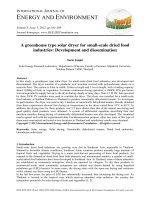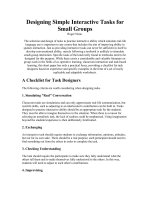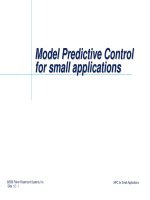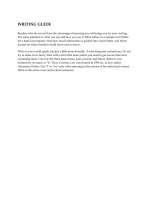tree planting procedure for small, bare root seedlings
Bạn đang xem bản rút gọn của tài liệu. Xem và tải ngay bản đầy đủ của tài liệu tại đây (273.88 KB, 4 trang )
David Mercker, Extension Specialist
Forestry, Wildlife and Fisheries
“It is better
not to have
planted,
than to have
planted
incorrectly.”
SP663
Extension
If key steps are not carefully followed during handling and planting,
mortality rate rises. Both hardwood and pine seedling survival is
more likely if attention is given to the following:
1. Plant in late fall or early winter.
n southern locations midecember
through midarch are the best months
for planting seedlings y planting well
before the growing season roots will
settle into their new environment and
prepare to supply water to the buds and
foliage when warmer temperatures arrive
2. Plant on cooler days.
emperatures that range between –
degrees are best for planting igher
temperatures cause transpiration to
Tree Planting Procedure
for Small, Bare-Root Seedlings
Tree seedlings
receive foremost care
while growing in a
managed nursery:
fertile soil; ample moisture; and
weed, insect and disease control.
Lifting seedlings out of this comfort
zone shocks them. Consider: they are
dislodged from the soil; their roots are
often torn; they are handled several
times; they are packaged, shipped,
exposed to wind and heat, and
placed in planting bags or machine
buckets; their roots are unveiled to
open air; and they are often replanted
in harsh soil where they are left to
high temperatures with the hope of
adequate precipitation for sustenance
through the first few growing seasons
(Figure 1).
Figure 1.
Black walnut
(Juglans nigra L.) seedlings
ready for machine
planting. Take care not to
expose the roots to air for
long periods.
Figure 2.
Hand planting is
more common with
small projects or in
difficult terrain.
increase and will dry the roots transpiration is the
process by which water vapor leaves a living plant and
enters the atmosphere ower temperatures could freeze
the roots causing mortality
3. Protect seedlings during vehicular transport.
ransporting seedlings in an enclosed vehicle is preferred
to openair transport over the bags of seedlings
with a tarp during transport igh winds increase
transpiration t is best to transport on cool days or at
cooler times of the day
4. Store seedlings properly.
ind a place to store your seedlings well ahead of their
arrival from the nursery f immediate planting is not
possible seedlings should be stored in an enclosed cooler
where temperature and moisture are regulated eeping
the air temperature low and the humidity high will
slow transpiration aintain air temperature at
degrees hen stacking bags of seedlings for long
storage periods crisscross them leaving large air gaps for
better ventilation therwise heat will build near the
center of the bags f temperaturecontrolled facilities
are not available or if the seedlings will be planted
quickly store the seedlings in a cool dark location away
from the wind in a cellar barn etc t is best not to
open the bags however if the bags cannot be stored in
a cool location open them periodically for inspection
to determine if watering is necessary e careful not to
add too much water ather keep seedlings moist not
saturated xcess water can harm the roots if left too
long
5. Treat seedlings properly at the
planting site.
eedlings can deteriorate rapidly
particularly once on the planting site
igh air temperature and wind will
stress the seedlings especially when
atmosphere humidity is low ark your
transport vehicle in the shade in lower spots shielding
the seedlings from destructive elements heat light and
wind nsulation tarps provide desirable protection
void opening the seedling bags until near the time
of planting void exposing the roots to the open air
for very long f air temperature reaches degrees
planting should cease arge portable coolers are ideal
for field storage of seedlings but are often not available
6. Plant seedlings using the best method.
wo methods are used for planting tree seedlings hand
planting and machine planting oth are acceptable
Hand planting igure is more common on steeper
terrain or in forested areas that have recently been
harvested eedlings are placed in planting bags then
hand tools such as a dibble bar or hoedad is used to
penetrate the soil and create an opening for the roots
nce the seedling is planted the hole is resealed with
the tool and foot pressure to close soil air pockets ake
care not to root the seedlings by jamming the roots
into the ground ather insert the roots in a natural
vertical position
machine planter is normally pulled behind a tractor
with a point hitch igure
he planter has a coulter slicing through the soil a
foot pulling the machine below surface level trencher
plates opening the soil for seedling placement and
packing wheels to reclose and compress the soil
achine planting as compared to hand planting
generally has a slightly better survival rate delivers more
consistency in spacing and works best when converting
old fields or pastures to forest rees can be improperly
planted with a machine he machine should not be
operated faster than mph causing the roots to become
crooked and the trees to lean rees and the machine
must be checked frequently especially when different
soil textures are encountered
lant seedlings deep at least to the original level planted
while in the nursery as noted by the darkened ring
where the lower stem meets the roots ts better to
plant slightly too deep than too shallow ake sure that
all air pockets are sealed by applying pressure to the
soil surrounding the seedling traighten seedlings as
needed e certain not to allow any lateral roots to be
exposed above the soil level
7. Conduct a survival check.
survival exam should be conducted near the end of
the first growing season ardwood trees may need to
be examined in late summer before the leaves turn color
and fall off he survival plots should be systematically
dispersed and measure onehundredth of an acre such
plots have a radius of feet inches f costshare
funds were used to establish the planting it may be
necessary to maintain a certain level or percentage of live
seedlings n most cases a survival rate of or more
trees per acre is recommended he original planting
plan should have specified this minimum survival level
our professional forester can assist with the survival
check and replanting recommendations
Figure 3.
Machine planting to restore
120 acres of bottomland row
crops to native hardwood
timber at the West Tennessee
Center for Research and
Education (January 2004).
Cost-share assistance for tree planting
from the federal or state government
is occasionally available. For more
information regarding planning and
implementing a tree planting project,
contact the Tennessee Department
of Agriculture, Forestry Division, at
615-837-5411 or />agriculture/forestry/index.html. If done
correctly, seedling survival is more likely,
and the benefits of forest restoration will
be enjoyed more quickly.
Programs in agriculture and natural resources, 4-H youth development, family and consumer sciences, and resource development.
University of Tennessee Institute of Agriculture, U.S. Department of Agriculture and county governments cooperating.
UT Extension provides equal opportunities in programs and employment.
SP663-1M-11/05 E12-4915-00-005-06 06-0096
Visit the UT Extension Web site at
/>Copyright 2005 The University of Tennessee. All rights reserved. This document may be reproduced and distributed for nonprofi t educational purposes
providing that credit is given to University of Tennessee Extension.









